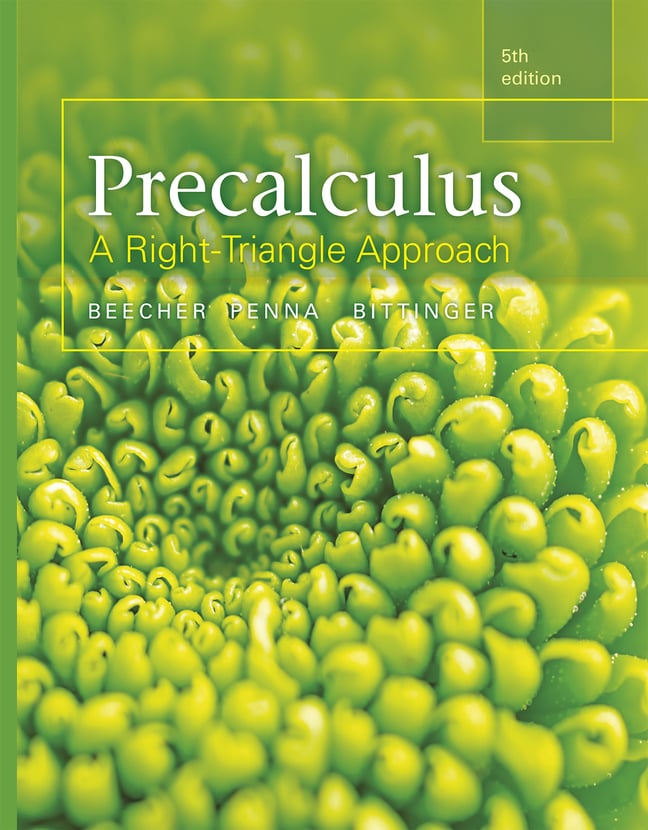
Precalculus: A Right Triangle Approach, 5th edition
- Marvin L. Bittinger
- , Judith A. Beecher
- , Judith A. Penna

- Find it fast
Quickly navigate your eTextbook with search
- Stay organized
Access all your eTextbooks in one place
- Easily continue access
Keep learning with auto-renew
For courses in Precalculus.
Prepare. Visualize. Succeed.
Precalculus: A Right-Triangle Approach helps students “see the math” through a focus on visualization and early introduction to functions, which allows for the use of graphs to provide a visual aspect to solving equations and inequalities. Specific features enable students to visualize and make connections between concepts. The 5th Edition expands and enhances instruction on review topics needed for corequisite courses or simply for students who come to the course underprepared. Ongoing review features throughout reinforce concepts and help students build understanding.
Published by Pearson (August 1st 2021) - Copyright © 2016
ISBN-13: 9780137617289
Subject: Precalculus, College Algebra & Trigonometry
Category: Precalculus
- Graphs, Functions, and Models
- 1.1 Introduction to Graphing
- 1.2 Functions and Graphs
- 1.3 Linear Functions, Slope, and Applications
- 1.4 Equations of Lines and Modeling
- 1.5 Linear Equations, Functions, Zeros, and Applications
- 1.6 Solving Linear Inequalities
- More on Functions
- 2.1 Increasing, Decreasing, and Piecewise Functions; Applications
- 2.2 The Algebra of Functions
- 2.3 The Composition of Functions
- 2.4 Symmetry
- 2.5 Transformations
- 2.6 Variation and Applications
- Quadratic Functions and Equations; Inequalities
- 3.1 The Complex Numbers
- 3.2 Quadratic Equations, Functions, Zeros, and Models
- 3.3 Analyzing Graphs of Quadratic Functions
- 3.4 Solving Rational Equations and Radical Equations
- 3.5 Solving Equations and Inequalities with Absolute Value
- Polynomial Functions and Rational Functions
- 4.1 Polynomial Functions and Models
- 4.2 Graphing Polynomial Functions
- 4.3 Polynomial Division; The Remainder Theorem and the Factor Theorem
- 4.4 Theorems about Zeros of Polynomial Functions
- 4.5 Rational Functions
- 4.6 Polynomial Inequalities and Rational Inequalities
- Exponential Functions and Logarithmic Functions
- 5.1 Inverse Functions
- 5.2 Exponential Functions and Graphs
- 5.3 Logarithmic Functions and Graphs
- 5.4 Properties of Logarithmic Functions
- 5.5 Solving Exponential Equations and Logarithmic Equations
- 5.6 Applications and Models: Growth and Decay; Compound Interest
- The Trigonometric Functions
- 6.1 Trigonometric Functions of Acute Angles
- 6.2 Applications of Right Triangles
- 6.3 Trigonometric Functions of Any Angle
- 6.4 Radians, Arc Length, and Angular Speed
- 6.5 Circular Functions: Graphs and Properties
- 6.6 Graphs of Transformed Sine and Cosine Functions
- Trigonometric Identities, Inverse Functions, and Equations
- 7.1 Identities: Pythagorean and Sum and Difference
- 7.2 Identities: Cofunction, Double-Angle, and Half-Angle
- 7.3 Proving Trigonometric Identities
- 7.4 Inverses of the Trigonometric Functions
- 7.5 Solving Trigonometric Equations
- Applications of Trigonometry
- 8.1 The Law of Sines
- 8.2 The Law of Cosines
- 8.3 Complex Numbers: Trigonometric Notation
- 8.4 Polar Coordinates and Graphs
- 8.5 Vectors and Applications
- 8.6 Vector Operations
- Systems of Equations and Matrices
- 9.1 Systems of Equations in Two Variables
- 9.2 Systems of Equations in Three Variables
- 9.3 Matrices and Systems of Equations
- 9.4 Matrix Operations
- 9.5 Inverses of Matrices
- 9.6 Determinants and Cramer’s Rule
- 9.7 Systems of Inequalities and Linear Programming
- 9.8 Partial Fractions
- Conic Sections
- 10.1 The Parabola
- 10.2 The Circle and the Ellipse
- 10.3 The Hyperbola
- 10.4 Nonlinear Systems of Equations and Inequalities
- 10.5 Rotation of Axes
- 10.6 Polar Equations of Conics
- 10.7 Parametric Equations
- Sequences, Series, and Combinatorics
- 11.1 Sequences and Series
- 11.2 Arithmetic Sequences and Series
- 11.3 Geometric Sequences and Series
- 11.4 Mathematical Induction
- 11.5 Combinatorics: Permutations
- 11.6 Combinatorics: Combinations
- 11.7 The Binomial Theorem
- 11.8 Probability